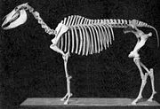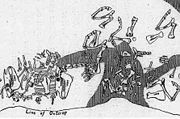
Equus scotti
Encyclopedia
Equus scotti is an extinct
species
of Equus
, the genus
that includes the horse
. E. scotti was native to North America
and likely evolved from earlier, more zebra-like North American equids early in the Pleistocene Epoch. The species may have crossed from North America to Eurasia
over the Bering land bridge during the Pleistocene. The species died out at the end of the last ice age in the large-scale Pleistocene extinction of megafauna
.
It was among the last of the native horse species in the Americas until the reintroduction of the horse approximately 10,000 years later, when conquistador
s brought modern horses to North and South America circa 16th century, some of which later escaped to the wild and became ancestors of the many feral horse
s living today in the Americas.
 Paleontological
Paleontological
and archaeological
recovery has identified the locations of numerous specific places where E. scotti occurred. The species was named from Rock Creek, Texas
, United States
, where multiple skeletons were recovered. A closely related fossil find was made of Equus bautisensis in California
; this species appeared closely related, but of a slightly more primitive form than E. scotti. However, E. bautisensis was redefined as a junior synonym of E. scotti in 1998 by paleontologist E. Scott, who also assigned fossils from the Anza-Borrego Desert in California, tentatively interpreted to represent E. bautistensis, to E. scotti. One of the reported locations farthest south in the Americas is Pali Aike National Park
in Chile
.
Extinction
In biology and ecology, extinction is the end of an organism or of a group of organisms , normally a species. The moment of extinction is generally considered to be the death of the last individual of the species, although the capacity to breed and recover may have been lost before this point...
species
Species
In biology, a species is one of the basic units of biological classification and a taxonomic rank. A species is often defined as a group of organisms capable of interbreeding and producing fertile offspring. While in many cases this definition is adequate, more precise or differing measures are...
of Equus
Equus (genus)
Equus is a genus of animals in the family Equidae that includes horses, donkeys, and zebras. Within Equidae, Equus is the only extant genus. Like Equidae more broadly, Equus has numerous extinct species known only from fossils. This article deals primarily with the extant species.The term equine...
, the genus
Genus
In biology, a genus is a low-level taxonomic rank used in the biological classification of living and fossil organisms, which is an example of definition by genus and differentia...
that includes the horse
Horse
The horse is one of two extant subspecies of Equus ferus, or the wild horse. It is a single-hooved mammal belonging to the taxonomic family Equidae. The horse has evolved over the past 45 to 55 million years from a small multi-toed creature into the large, single-toed animal of today...
. E. scotti was native to North America
North America
North America is a continent wholly within the Northern Hemisphere and almost wholly within the Western Hemisphere. It is also considered a northern subcontinent of the Americas...
and likely evolved from earlier, more zebra-like North American equids early in the Pleistocene Epoch. The species may have crossed from North America to Eurasia
Eurasia
Eurasia is a continent or supercontinent comprising the traditional continents of Europe and Asia ; covering about 52,990,000 km2 or about 10.6% of the Earth's surface located primarily in the eastern and northern hemispheres...
over the Bering land bridge during the Pleistocene. The species died out at the end of the last ice age in the large-scale Pleistocene extinction of megafauna
Megafauna
In terrestrial zoology, megafauna are "giant", "very large" or "large" animals. The most common thresholds used are or...
.
It was among the last of the native horse species in the Americas until the reintroduction of the horse approximately 10,000 years later, when conquistador
Conquistador
Conquistadors were Spanish soldiers, explorers, and adventurers who brought much of the Americas under the control of Spain in the 15th to 16th centuries, following Europe's discovery of the New World by Christopher Columbus in 1492...
s brought modern horses to North and South America circa 16th century, some of which later escaped to the wild and became ancestors of the many feral horse
Feral horse
A feral horse is a free-roaming horse of domesticated ancestry. As such, a feral horse is not a wild animal in the sense of an animal without domesticated ancestors. However, some populations of feral horses are managed as wildlife, and these horses often are popularly called "wild" horses...
s living today in the Americas.
Distribution

Paleontology
Paleontology "old, ancient", ὄν, ὀντ- "being, creature", and λόγος "speech, thought") is the study of prehistoric life. It includes the study of fossils to determine organisms' evolution and interactions with each other and their environments...
and archaeological
Archaeology
Archaeology, or archeology , is the study of human society, primarily through the recovery and analysis of the material culture and environmental data that they have left behind, which includes artifacts, architecture, biofacts and cultural landscapes...
recovery has identified the locations of numerous specific places where E. scotti occurred. The species was named from Rock Creek, Texas
Texas
Texas is the second largest U.S. state by both area and population, and the largest state by area in the contiguous United States.The name, based on the Caddo word "Tejas" meaning "friends" or "allies", was applied by the Spanish to the Caddo themselves and to the region of their settlement in...
, United States
United States
The United States of America is a federal constitutional republic comprising fifty states and a federal district...
, where multiple skeletons were recovered. A closely related fossil find was made of Equus bautisensis in California
California
California is a state located on the West Coast of the United States. It is by far the most populous U.S. state, and the third-largest by land area...
; this species appeared closely related, but of a slightly more primitive form than E. scotti. However, E. bautisensis was redefined as a junior synonym of E. scotti in 1998 by paleontologist E. Scott, who also assigned fossils from the Anza-Borrego Desert in California, tentatively interpreted to represent E. bautistensis, to E. scotti. One of the reported locations farthest south in the Americas is Pali Aike National Park
Pali-Aike Volcanic Field
Pali-Aike Volcanic Field is a Pleistocene-to-Holocene volcanic field in Patagonia on the Argentina–Chile border, located north of the Straits of Magellan about 150 km northeast of Punta Arenas, Chile. The volcanic field contains lake-filled maars, along with basaltic scoria cones and spatter...
in Chile
Chile
Chile ,officially the Republic of Chile , is a country in South America occupying a long, narrow coastal strip between the Andes mountains to the east and the Pacific Ocean to the west. It borders Peru to the north, Bolivia to the northeast, Argentina to the east, and the Drake Passage in the far...
.

